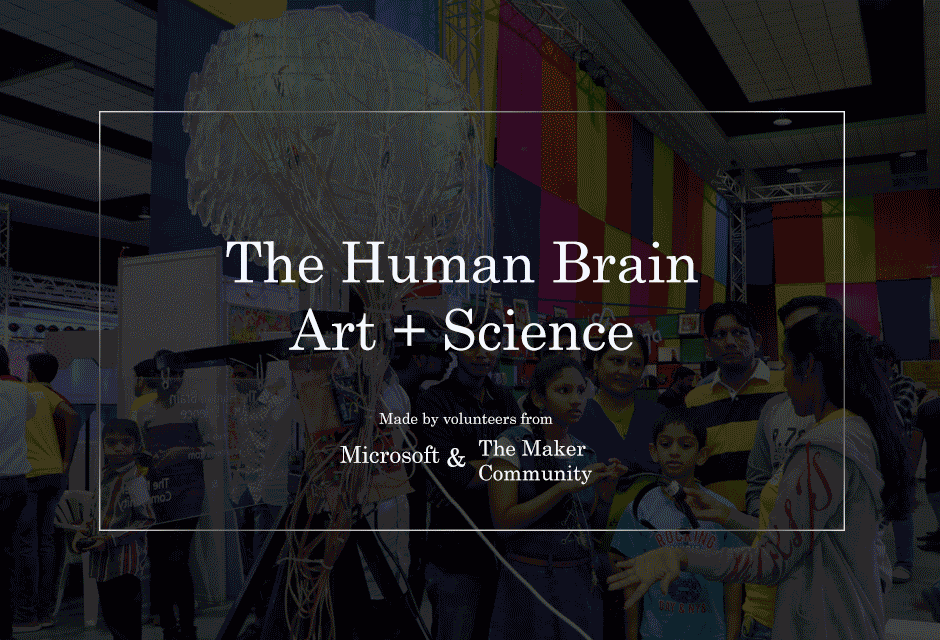Stroke of genius: Real-time simulation of the human brain
The human brain is referred to as the ‘crowning glory of evolution.’ It contains 86 billion brain cells known as neurons. Each neuron has an average of 7,000 connections to other neurons known as synapses. Our brains form millions of new synapses every second – resulting in constantly changing patterns and strength. These connections store experiences, create habits and shape personalities.
At the India edition of Maker Faire 2018 organized in Hyderabad earlier this month, volunteers from Microsoft Garage India collaborated with members of the external Maker Community to demonstrate the functioning of the human brain. Their project, the Brain Installation, showcased the power of art and technology. The objective of the structure was to simulate the anatomy of the human brain in a simple and comprehensible manner for the audience.
The anatomy of the human brain
The human brain controls every movement, thought and emotion. Given that the brain is a highly complex structure, it comprises of many intricate sub-structures and parts. In this phase of the Brain Installation project, which was incidentally also the first part, our focus was chiefly on the cerebral cortex. The cerebral cortex, which is a part of the cerebrum, is the outermost part of the brain. It is also the part responsible for distinct human traits such as memory, rational thinking and imagination as well language and consciousness. In effect, the cerebral cortex makes us superior to other species. This part is segmented into four lobes which are associated with a wide spectrum of functions ranging from reasoning to auditory perception.
| Lobe | Functions | ||
|
|
||
|
|
||
|
|
||
|
|
Most brain functions are processed in multiple lobes since they work in conjunction with each other. They are strongly connected through a complex network of neurons. For instance, the process of higher-level decision making – unique to human beings – utilizes the frontal and prefrontal lobes. Both these regions are responsible for intelligent thought, complex calculations and cognition.

The brain installation
To build the brain model, volunteers from Microsoft Garage studied a 3D model of the brain – slicing it into different parts and lobes. They then used a software to create a 2D drawing of all the slices. This understanding was applied to the final structure – the brain installation.
The brain installation was an acrylic structure weighing about 100 kg. The overall size of the structure was around 2.5 feet in length and height. It measured about 2 feet in width. Different slices of acrylic sheets, each measuring about 6 mm thick represented different parts of the brain. Around 25 slices were assembled longitudinally whereas 13 slices were stacked horizontally. The structure was supported by a metallic base and was propped up at a height of 7 feet.
Further, around 350 LED lamps were used to light up different sections of the brain structure. Each color represented a different part.
How did the brain installation work?
The brain installation was an amalgamation of various technologies and software. Given below is the detailed process of its functioning:
- Volunteers wore an electroencephalography (EEG) This is a brainwave sensing instrument that monitors and records the electrophysiological activity of the brain. In this case, our volunteers used the Neurosky MindWave Mobile headset, which had electrodes placed along the scalp of the volunteer.
- The sensors in the headset could detect, measure and record EEG power spectrums (brain waves such as alpha waves, beta waves, gamma waves etc) data[1]. The data could also be exported to third-party applications for downstream data analysis and processing.
- The data gathered by the EEG headset was deployed by a C# program developed by Garage volunteers. The C# program was designed using a machine learning model to map the emitted brain waves to the respective lobes.
- The output from the C# program was captured in a microcontroller (Arduino Mega) which in turn would send signals to the PCB (designed and manufactured by the Garage Team).
- The PCBs were designed to send signals to the brain installation and light up parts which were activated.
When a volunteer donned the EEG headset, he would see the structure light up to reflect the exact portion of his brain activated at that movement. Further, the lighting would change to showcase different parts of his brain being stimulated when the volunteer changed his activity.
For instance, if a volunteer were to be connected to the brain installation while reading this article, the Broca’s area (which is responsible for language processing) and the hippocampus (which controls the curiosity trait) would be illuminated. Likewise, when you are amid a task that requires high concentration, the structure would indicate that the prefrontal and parietal cortex of your brain are at work.
Taking the project forward
Commenting on the success of the project, Reena Dayal Yadav, Director, Microsoft Garage – India said, “The human brain is most fascinating and we have so much to learn from how the brain functions. The brain installation provided a rare experience by demonstrating some of the activities and the corresponding part of the brain. The model piqued the curiosity of members of all age groups and was widely appreciated by the audience.”
The volunteers at Microsoft Garage are currently working towards increasing the accuracy of the brain installation.
[1] https://store.neurosky.com/products/mindset-research-tools